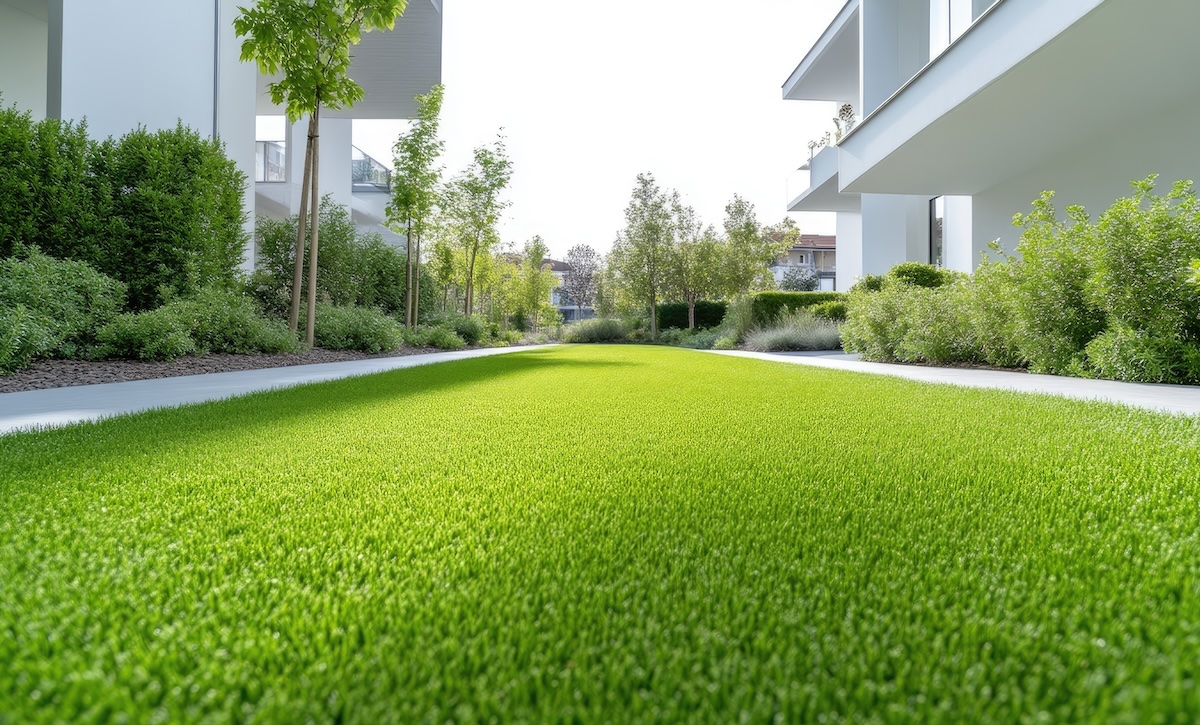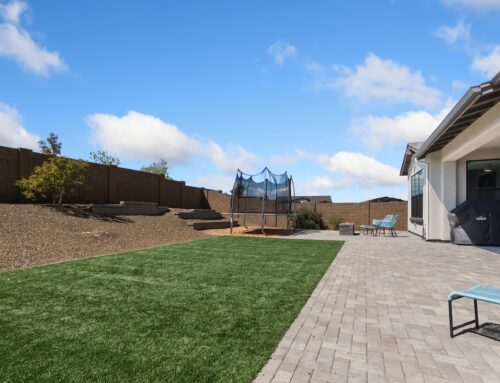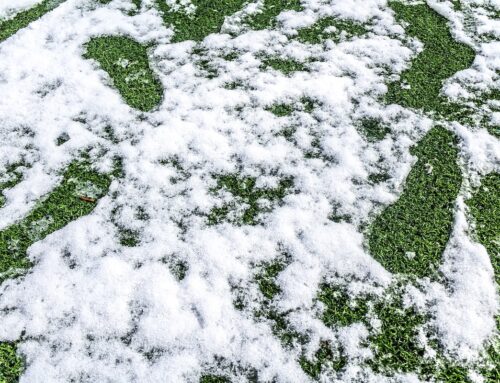Last Updated on October 8, 2025 by ReTurf
When folks around here talk about going green, they’re usually thinking about installing energy-efficient windows, or maybe a good HVAC system. But landscaping plays a big role, too—whether you’re working on a new build, freshening up a tired yard, or managing a commercial property that needs to look good and last.
The truth is, landscaping is one of the most overlooked areas when it comes to sustainability.
It tends to fly under the radar in most sustainability conversations—especially compared to things like energy-efficient appliances or solar panels. Yet according to the EPA, outdoor water use alone accounts for more than 30% of household water consumption in the entire U.S.—and that number jumps much higher to 60% in dry regions.
(Add in the energy and emissions tied to mowing, fertilizing, and maintaining traditional lawns, and it’s clear that what you plant and how you manage it matters more than most people realize.)
But it doesn’t have to be that way. These days, we’ve got solid options—from synthetic turf to recycled stone and mulch—that can lower maintenance, save water, and still look sharp year-round, whether you’re in a humid coastal zone or a drought-prone desert area.
Location really matters: sustainable landscaping solutions should be tailored to your local climate and soil conditions to get the best results.
So if you’re looking to build a sustainable yard or landscape from the ground up, here’s what to know when it comes to choosing green materials that last—and make sense long-term.
Start with What You’re Replacing (or Avoiding)
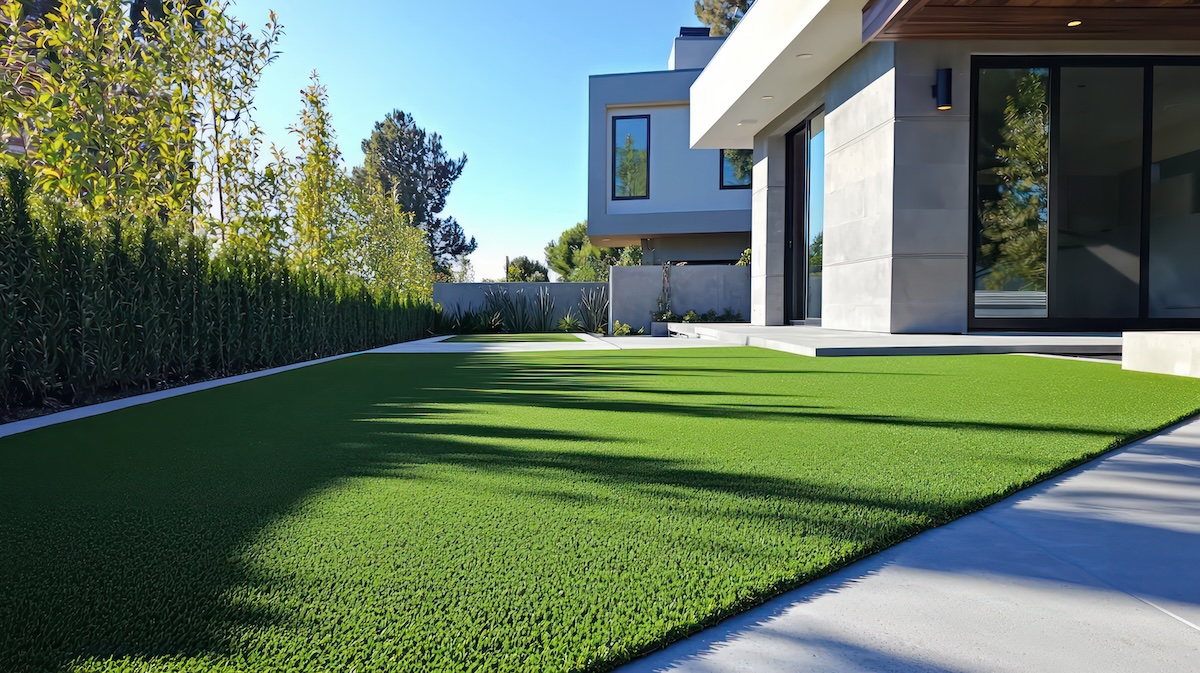
Before we get into the sustainable stuff, take a step back and think about what you’re replacing—or what headaches you’re trying to avoid. Are you dealing with patchy, high-maintenance grass? Wood decking that’s seen better days? Rock beds that somehow still manage to get overrun with weeds?
Knowing what’s not working helps you choose upgrades that solve those problems instead of just shifting them around.
For example:
- Natural wood decking might look nice for the first season or 2, but it comes with a constant maintenance cycle: sanding, staining, sealing, and replacing boards as they warp or rot. Not to mention the environmental cost of sourcing tropical hardwoods or pressure-treated lumber that often can’t be recycled down the road.
- Live grass may be the default in most American neighborhoods, but it’s a resource hog. A typical suburban lawn in the U.S. uses an estimated 10,000 gallons of water per year, and that doesn’t count the fuel burned by mowers, or the chemicals used in fertilizers and weed treatments—many of which eventually wash into local streams or storm drains. Even then, your lawn can still burn out during a hot Missouri summer or freeze out in a rough Minnesota winter.
- Drainage issues are another silent budget killer. When runoff erodes your mulch or topsoil, not only are you paying to replace those materials, but you’re also likely contributing to downstream sediment pollution—especially in older neighborhoods without modern stormwater systems.
Knowing your pain points helps pick the right materials that are actually sustainable—not just labeled that way.
Landscaping makes up about 5% of air pollution in the US annually. (Source: Utah Department of Environmental Quality) In another study, gasoline-powered lawn and garden equipment was found to emit approximately 26.7 million tons of air pollutants, accounting for 24%–45% of all nonroad gasoline emissions in the U.S.
Synthetic Grass
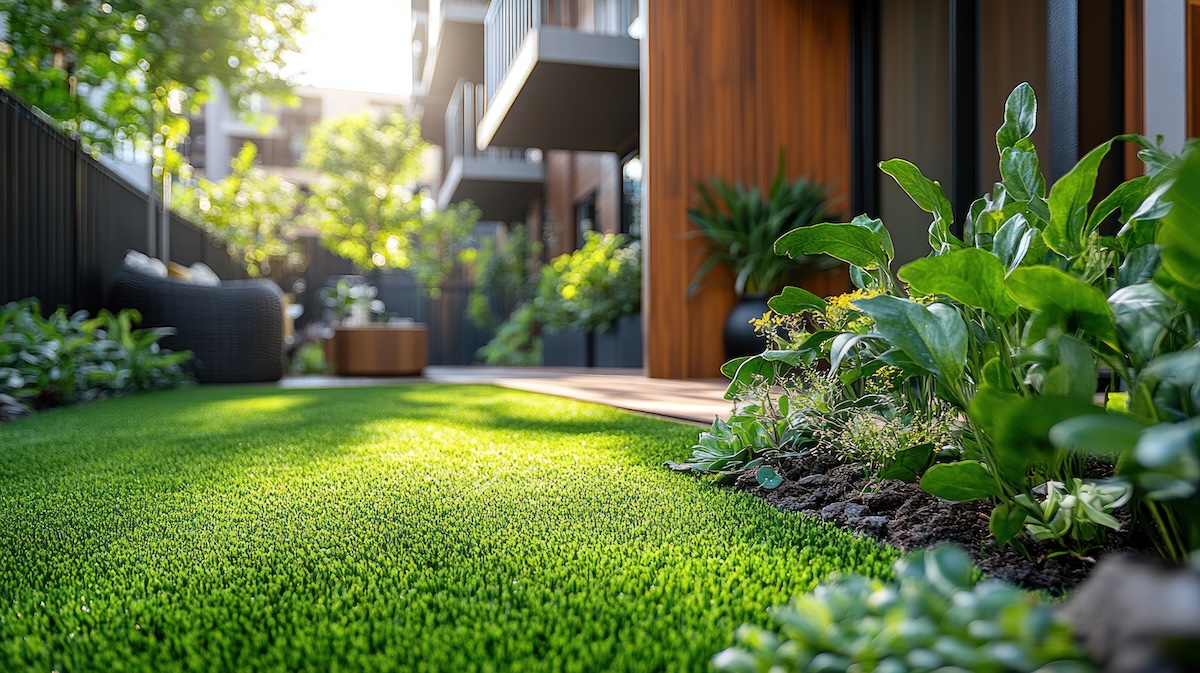
Artificial turf has come a long way since the old-school, neon-green turf from decades ago. These days, we’re seeing high-end synthetic grass that looks real like actual fescue or Kentucky bluegrass—and performs better in a lot of ways.
Why It’s Sustainable
- Water Savings: You’ll cut irrigation costs to almost nothing.
- No Fertilizer or Pesticides: Safer for kids, pets, and groundwater.
- Durability: Modern turf lasts 15–20 years or more with minimal upkeep.
- Recyclable Options: A small number of turf products like are wholly or partially recyclable at the end of their lifespan. (Tempo Turf is 100% recyclable.)
- Used Turf Markets: Yes, used synthetic grass is a thing—repurposing rolls of used sports turf from stadiums or overstock jobs can save money and keep tons of materials out of landfills.
What to Look For
Not all turf is created equal, so here’s what we recommend looking into:
- Infill Material: Avoid crumb rubber if off-gassing is a concern—look into organic or silica sand infills.
- Backing Type: Polyurethane backing lasts longer but isn’t always recyclable. Polypropylene or newer PET backings are easier to process for reuse.
- Drainage Design: Make sure the turf you choose has proper perforation to handle stormwater runoff.
If your project is aiming for LEED certification—which is often the case in commercial builds or larger residential developments like apartment complexes—then the kind of artificial turf you use can actually help contribute points toward that certification. But not just any turf qualifies.
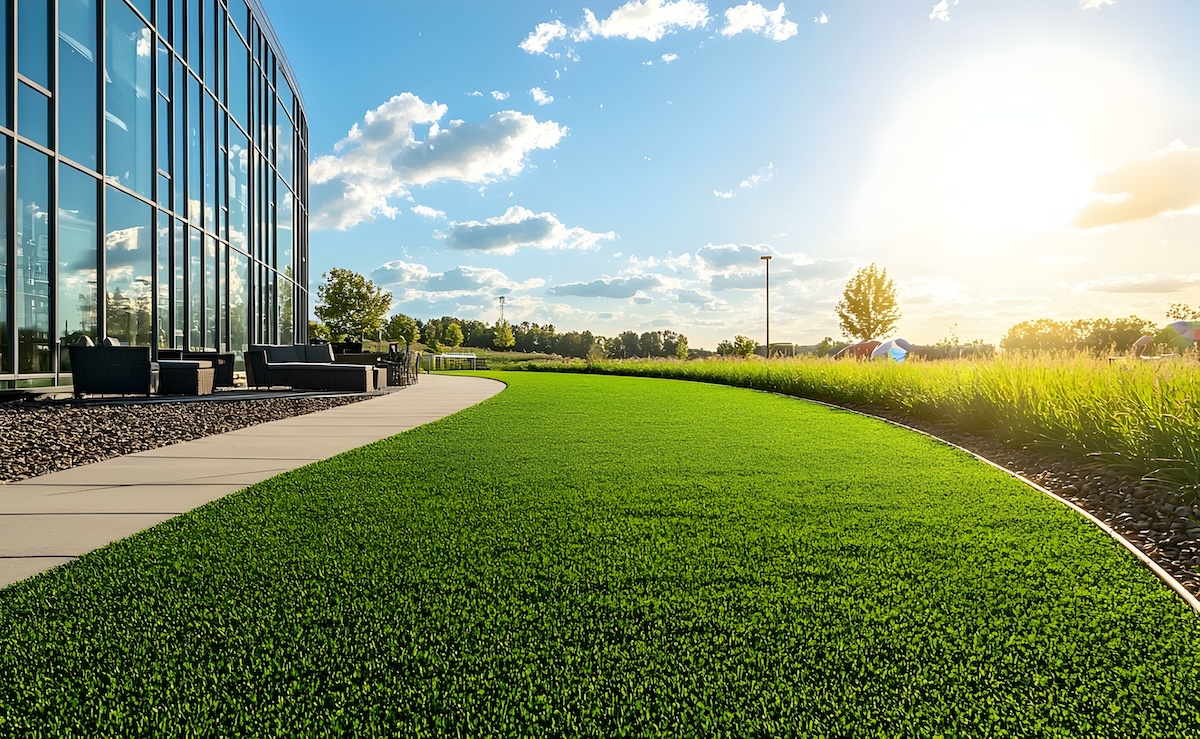
Under LEED v4 and v4.1, artificial turf can contribute to points in the Materials and Resources category, especially if it includes recycled content or is regionally sourced (to reduce emissions from transportation). Some turf products are made with post-consumer recycled plastic or rubber, and others are manufactured locally—factors that can help v4/v4.1 projects earn credits in the Materials and Resources category of LEED.
So, if you’re selecting turf and LEED is on the table, you’ll want to look beyond just aesthetics and durability—check if the product documentation specifically calls out compliance with LEED v4 recycled content or regional sourcing criteria.
Important Update: As of April 2025, LEED v5 has been officially released by the U.S. Green Building Council (USGBC), marking a significant update to the LEED certification system. While LEED v4 and v4.1 are still valid for project registration, the new LEED v5 has a stronger focus on decarbonization, equity, and measurable building performance, with about 80% of points tied to outcomes like carbon reduction and ecological impact. It has new prerequisites and credits that emphasize climate resilience, human health, and lifecycle emissions. As of this update, LEED v5 has not provided explicit credit pathways for artificial turf, so it’s important to stay informed about any future updates or clarifications from the U.S. Green Building Council. New projects are encouraged to adopt LEED v5 to align with the latest standards and practices, however at this time LEED v4/v4.1 are still valid for registration, and projects under those versions remain eligible for turf-related credits.
Used Artificial Turf
It might sound odd at first, but there’s a growing demand for used turf—and it’s for very good reason. Much of this turf comes from athletic fields, stadiums, or large commercial installations that are replaced on a regular cycle for performance or aesthetic upgrades, not because the material is actually worn out.
In many cases, the turf still has years of functional life left and is perfectly suitable for residential, recreational, or lower-impact commercial use. You’ll also find used turf available from overstock inventory, canceled projects, or even new turf remnants from sections trimmed during large installations. These sources provide high-quality material at a fraction of the cost of new turf, while also keeping perfectly usable product out of landfills.
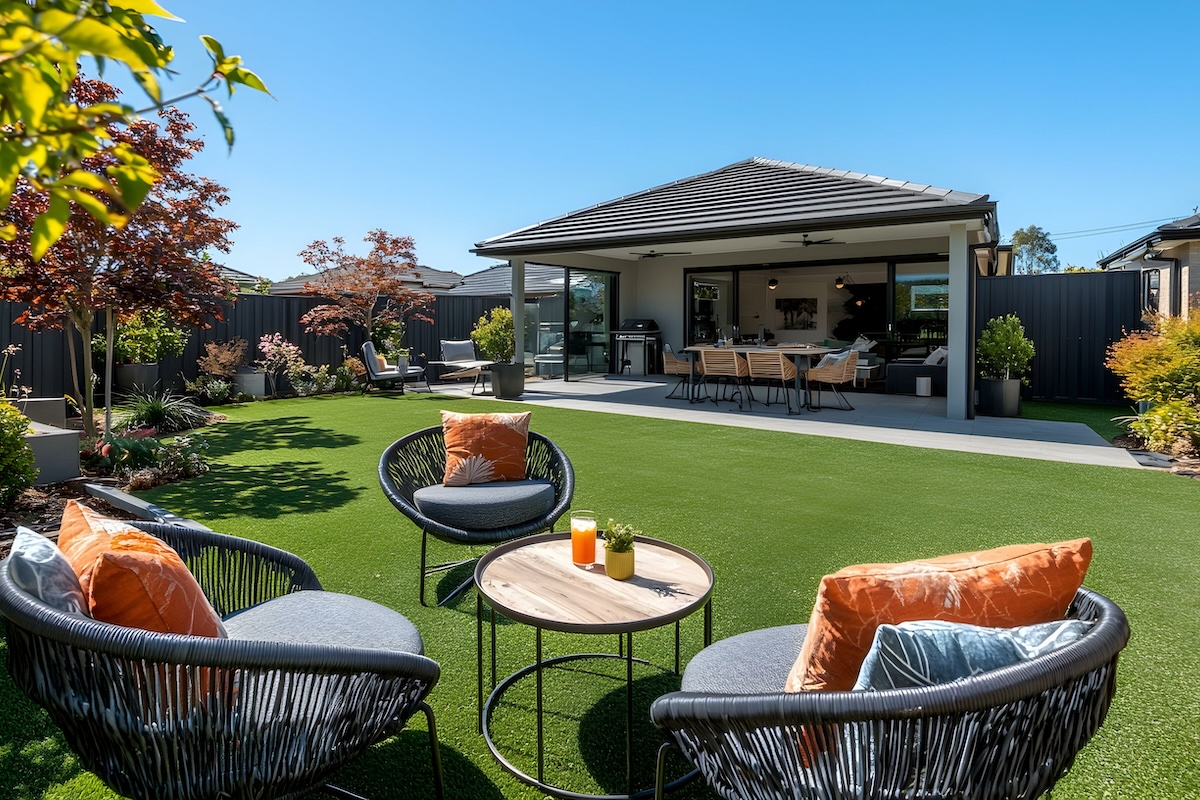
Now, used turf may not be a perfect fit for every project, especially those needing a pristine look. (Note that used artificial turf without lines/markings and 100% recyclable artificial turf is available for situations where aesthetics are a higher priority.) But for many applications, it’s a smart, sustainable choice that balances performance, cost, and environmental responsibility.
Pros of Going Used
- Lower cost per square foot
- Diverts material from landfills
- Still durable for most landscaping purposes
- Great for dog runs, rental properties, or areas where visual perfection isn’t critical
Just make sure you inspect it, or buy from a reputable supplier that grades their rolls clearly. You want something with intact backing, even pile height, and no contamination.
Used (or reclaimed) artificial turf can contribute to LEED points—but with some caveats:
- Reused Materials Credit (MR Credit: Building Product Disclosure and Optimization – Sourcing of Raw Materials)
- LEED v4 encourages reusing materials to reduce demand for virgin products and minimize landfill waste.
- If you use salvaged or reused turf in your project, it may contribute toward this credit if properly documented.
- You’ll need proof that the turf was salvaged from another site and reused in a way that maintains its integrity and function.
- Waste Reduction (Construction Waste Management)
- If you divert used turf from a landfill by reusing it, it could support credits related to construction waste reduction.
- This generally applies to overall jobsite waste practices, not materials individually—so used turf is one part of a bigger picture.
- Regional Material Considerations
- If the reused turf was sourced within 100 miles of the project site, it may strengthen a project’s case for “regional” sourcing—but only as part of a broader material mix.
- Limitations
- Most of the high quality used artificial turf on the market come from stadiums, sports complexes, or large fields that are being renovated. That means the turf itself originally came from a reputable manufacturer and may well have had documentation like Environmental Product Declarations (EPDs), recycled content data, or VOC/emissions testing at the time of installation.
- Even if the original manufacturer provided those documents, they’re not automatically transferable to the used product. Thus, used turf typically lacks current manufacturer documentation for recycled content, emissions testing, or ingredient disclosure. Because of this, which makes it less likely to contribute towards specific technical credits like Material Ingredient Reporting or EPDs.
Even with the limitations above, used turf can still be a smart choice in LEED projects aiming for material reuse and construction waste reduction credits. It keeps materials out of landfills, avoids the resource demands of manufacturing new products, and—if sourced locally—can even support regional material goals.
For the right project, it’s a sustainable move that aligns with both environmental and budget priorities.
The bottom line: Used turf can help with LEED v4/v4.1 credits tied to material reuse and waste diversion, it just probably won’t qualify for the credits tied to verified recycled content or manufacturer transparency.
Other Sustainable Landscaping Materials Worth Considering

While synthetic turf can be a smart anchor for a water-wise, low-maintenance lawn and green areas, sustainable landscaping will often combines several thoughtful material choices. The most resilient, eco-friendly landscapes reduce upkeep while working with the local environment, minimizing waste, and making use of what already exists.
Here are a few additional materials and strategies that can help complete a sustainable landscape design—each with its own benefits for longevity, environmental impact, and overall performance:
Use Native and Drought-Tolerant Plants
Native plants are species that naturally grow in your region—and they’ve adapted over generations to thrive in your local soil, rainfall, and climate. That means they typically need less water, fewer fertilizers, and far less pest control than non-native ornamentals or turf grasses. Even better, they support local wildlife like pollinators, birds, and beneficial insects.
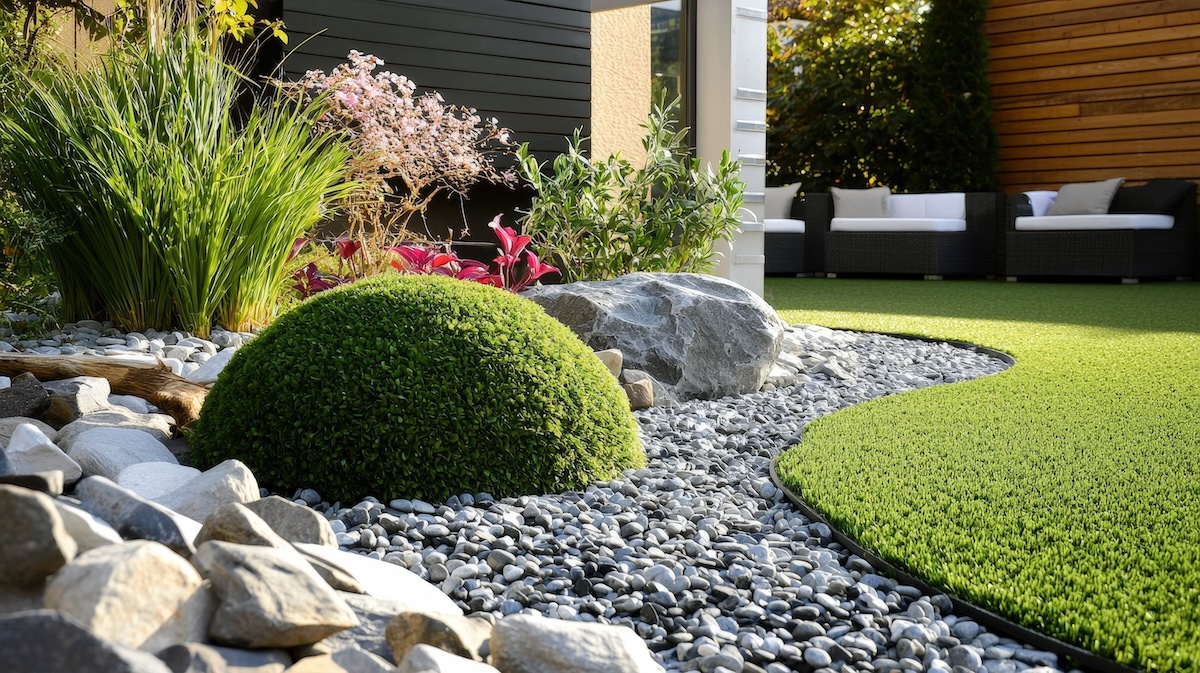
Drought-tolerant plants, also called xeriscaping plants, aren’t always native but are selected specifically for their ability to thrive with minimal water. Consider ornamental grasses, lavender, salvia, sedum, or native succulents.
- Reduced Water Use – Once established, native and drought-tolerant plants can often survive on rainfall alone.
- Less Maintenance – You’ll spend less time mowing, fertilizing, or spraying.
- Biodiversity Boost – Native plants help support ecosystems and reduce the spread of invasive species.
Tips:
- Group plants by water needs (called hydrozoning) to make irrigation more efficient.
- Use mulch around plant beds to retain moisture and suppress weeds.
- Check with your local extension office or native plant society—they often offer free or low-cost guides for your area.
Native landscaping isn’t just eco-friendly—it’s also beautiful, with seasonal color changes, textures, and even wildlife activity that can give your yard a dynamic, living feel year-round.
Recycled Mulch
- Made from ground-up pallets or rubber tires
- Won’t fade as fast as traditional bark
- Doesn’t wash away as easily in storms
Reclaimed Pavers and Stone
- Local stone yards often have leftover inventory like pavers or cutoffs from larger jobs
- Gives you a rustic, authentic look without needing new quarrying
Composite Decking
- Made from recycled plastics and wood fibers
- Holds up better than real wood in moisture-heavy climates
- No need for staining, sanding, or sealing
Permeable Hardscapes
- Permeable pavers let rainwater soak into the ground instead of running off
- Helps with local drainage and erosion issues
- Often contributes to LEED credits, depending on use
-
Smart Irrigation Systems
If you’re keeping some natural plant beds, upgrade your irrigation system to include moisture sensors or drip lines. That way, you’re not watering when it’s already rained.
Things to Watch Out For
Let’s not pretend every “green” product is actually good for the environment. Some things get marketed that way but fall apart in real-world use or have a big footprint to produce in the first place.
A few things worth double-checking:
- Plastic edging or borders—While inexpensive and easy to install, many low-grade plastic edging products are made from virgin plastic, aren’t recyclable, and tend to become brittle with seasonal freeze-thaw cycles. Over time, they can crack, shift out of place, or break down under UV exposure, leading to more frequent replacements and additional waste. Opt for edging made from recycled or durable composite materials when possible—especially those rated for extreme temperatures.
- Imported stone or wood—A product might be marketed as “eco-friendly,” but if it’s been quarried or harvested overseas and shipped thousands of miles, the carbon footprint from transportation can significantly offset its environmental benefits. In some cases, imported tropical hardwoods come from regions with poor forestry oversight, raising additional concerns about deforestation. Locally sourced or reclaimed materials—such as salvaged stone, regional quarry cutoffs, or domestic wood alternatives—typically offer a more sustainable and transparent supply chain.
- Brand new artificial grass with no end-of-life plan is a sustainability “red flag.” Most synthetic turf products on the market are difficult to recycle, especially if the manufacturer doesn’t use recyclable materials. The most sustainable turf options are those designed with full lifecycle thinking—meaning they can be reused, repurposed, or recycled once they’ve reached the end of their initial use. Look for suppliers like ReTurf who offer reclaimed turf or can point to specific recycling pathways, which helps keep usable materials out of landfills.
Final Thoughts
Practical Sustainability Wins Every Time

Sustainability doesn’t have to mean sacrificing durability or looks. In fact, the best green landscaping materials are the ones that last longer, require less maintenance, and solve real problems without creating new ones.
We’ve installed a lot of synthetic turf and low-maintenance landscapes over the years, and the homeowners who go that route usually say the same thing: “Should’ve done this sooner.”
So if you’re thinking about making the switch, take your time, look at your options, and think long-term. Choose quality materials that’ll stand up to your region’s specific climate—whether that means heavy snow, intense sun, or seasonal downpours—work with your property, and make your life easier.
And hey—if it also saves you water, yard work, and some cash over the years? That’s just good sense.
Need help picking the right turf or sustainable materials for your yard? A good supplier or installer will walk you through it. You can always reach out to the artificial turf experts at ReTURF, who specialize in used and eco-friendly recyclable artificial turf, know what works in different climates, and have experience making it look good and last. Call our team at (828) 518-5787 or click here to contact us.

